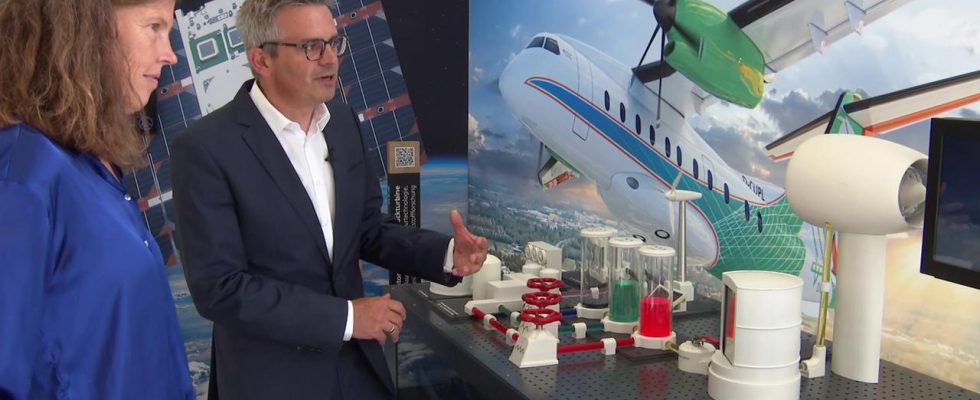How can flying be made more sustainable? This is one of the central topics at the German Aerospace Congress in Stuttgart. The road to emission-free aviation is still a long one.
The flame is completely blue: a good sign for the scientists at the Institute of Combustion Technology at the German Aerospace Center (DLR) in Stuttgart. Here in the laboratory they are testing a new, more efficient fuel chamber for aircraft turbines.
A blue flame means: Almost all components of the fuel in the chamber are burned. “A flame – we know it from a candle – always glows yellow,” explains institute director Andreas Huber. This is due to the soot particles that are produced during combustion.
The flame glows blue. Almost all fuel components are burned.
causes soot contrails
But that’s exactly what you don’t want with modern aircraft turbines. The soot that is currently released when conventional kerosene is burned creates contrails behind aircraft. And these, in turn, are harmful to the climate: the artificial clouds prevent the earth’s heat from being radiated back into space. So they increase the greenhouse effect. According to many experts, these so-called “non-CO2 emissions” are even more harmful than the CO2 released in aircraft turbines.
The goal is therefore quasi-emission-free flying. “Here we have a combustion chamber system that is effectively emission-free. Not completely, but almost,” says institute director Huber, looking at the blue flame in his laboratory.
A great joint effort
New combustion chambers are one of the two major components of his research, new fuels are the other. The institute is developing alternatives to conventional kerosene – for example from leftover cooking fat. The goal: completely “green” fuels for aviation with modern, highly efficient turbines.
“If this goes hand in hand, the optimization of the fuel together with the optimization of the combustion chamber, then we are able to enable quasi-emission-free flying,” says Huber. But there is still a long way to go – and a great joint effort by everyone involved.
pioneering spirit and Lighthouse projects are asked
This is one of the reasons why Huber is presenting his results at the German Aerospace Congress in his hometown of Stuttgart. Under the patronage of the German Aerospace Society (DGLR), more than 1,000 participants will discuss the future of flying. The ultimate goal: networking and exchange.
“It takes a pioneering spirit and the necessary flagship projects to inspire people beyond the industry for the future,” says DGLR President Roland Gebhardts. There are many ideas: flying with hydrogen, flying with fuel cells. The problem: These techniques are still in their infancy.
For longer flights, classic turbines will probably continue for a long time
“These are essential components for making air traffic climate-friendly,” says DLR Institute Director Huber. But it is also a fact that fuel cells and hydrogen-powered aircraft engines are not yet ready. “Technologically speaking, it will still take some time until they have penetrated the market,” says Huber. Because both technologies require completely new aircraft. Especially for medium and long-haul flights, the most climate-damaging area in aviation, we will probably have to rely on classic aviation gas turbines for a very long time.
That’s why he and his team continue to optimize existing combustion chambers and fuels. Theoretically, aircraft gas turbines could already be filled with up to 50 percent of alternative fuels, for example from leftover cooking fat or other organic waste – new engines could even be filled with up to 100 percent.
“It will take decades”
Politicians also want to put more pressure on the industry: According to an EU decision, aircraft fuels should contain at least two percent of “green” fuel by 2025 – by 2050 the proportion should gradually increase to up to 70 percent. The problem: Alternative fuels are still significantly more expensive. Many are also not yet approved.
This is also why DLR man Huber is still cautious with a forecast: “If everyone really pulls together, then we have the opportunity to become significantly more climate-friendly,” he says. However, he cannot say when the industry will truly be climate neutral. “It will certainly take a few more decades.”

